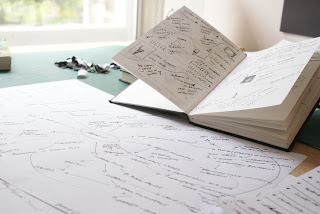When to make is
just as important as what to make, especially if you’re not in a commercial
engine. I’ve been trying to work out where to go next with the project. A show? It seems the most obvious thing to do,
but of course one has to negotiate the politics of space – which takes time. In
the mean time the job is to find other kinds of outcomes and developmental
activity that can exist independently of the gallery gig. So I’m spending more
time in libraries again, digging up books about saints. I came across The Making of a Saint by Catia Galatoriotou. Immediately I was drawn to the idea of ‘making’ in the
title, and the book goes on to talk about sanctification as social process, man
made rather than god sent.
One of the
continuing conversations and ambitions of many ethnically diverse artists is to
amplify stories that have been left unheard. Things have to be evidenced in the
world to prove existence. From a
personal point a view I will admit a certain amount of amnesia. History for me
has always been problematic, so it’s a surprise even to me that I picked a
‘historic’ figure.
What I like about
this process of hagiography (documenting of the lives of saints) is its blatant
conflation of fragments of fact and fiction. These saints who started as
mortals, have their lives mixed up with other mortals, then coupled with
fantastic happenings (miracles) and additionally many of these stories can be tied
with the political currents of the time. So although many of these tales are
complete fabrications, they have historical gravitas due to the amount of
industry that has gone into preserving and evidencing them. I keep thinking about the status of the
object when its not on show, how artists are always having to prove and
validate the existence of the things they make. So I’m thinking of a book
inspired by this process of hagiography, combining the things that I’ve already
found and made, with the things I haven’t found or made yet perhaps - then
maybe the odd fantastical happening…


No comments:
Post a Comment